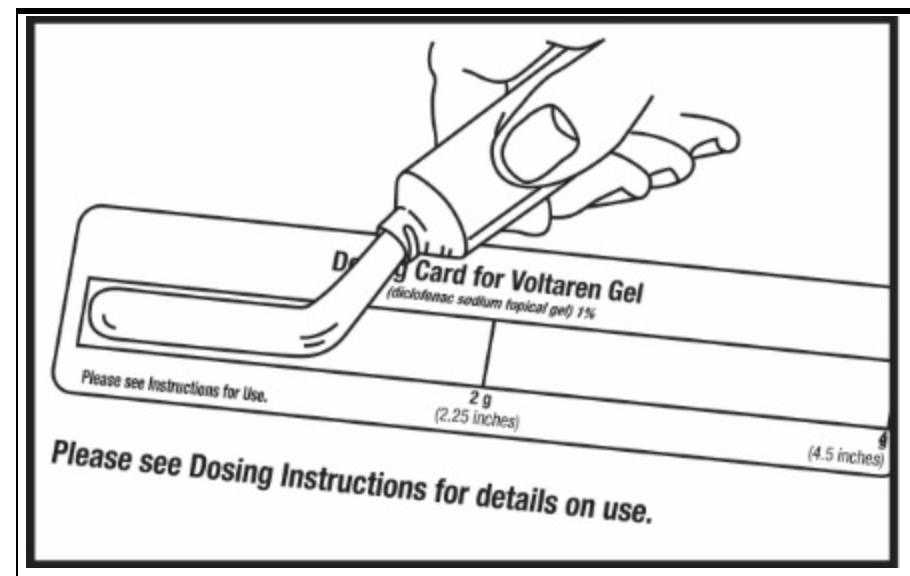Diclofenac gel can be a beneficial tool in the management of localized osteoarthritis pain. There are many situations where acetaminophen is not effective and oral NSAIDs are intolerable or inappropriate. This is a type of situation where diclofenac gel may be appropriate to consider. Here are a few mistakes and clinical pearls that you should know regarding this medication.
Where Can We Use Diclofenac Gel?
The location of the pain is critical when it comes to the use of diclofenac gel. The knee, elbow, hand, and wrist are all appropriate joints to use this localized therapy on. Many patients will have osteoarthritis of the hip. The hip is not a good place to utilize this medication.
How Much Do I Put On?
Below is an image of the dosing card that comes with Voltaren gel. This is really helpful when educating patients or healthcare professionals about how much a patient should utilize. A helpful tip to remember is that we are going to typically use 2 grams for an upper extremity joint and 4 grams for a lower extremity joint.

What About Systemic Absorption?
It has a relatively low amount of drug systemically absorbed. From the package insert, there is about 6% of the drug absorbed compared to the oral formulation. This means that the renal, GI, and other potential negative risks from topical diclofenac should be very low compared to oral dosage forms. Compare this to a drug like fentanyl which has a very high level of systemic absorption and is going to have the typical opioid adverse effect profile.
Cost
This is one of the big downsides of the drug. Cost concerns are a legitimate issue with diclofenac gel and prior authorizations are often the norm. It is important to recognize whether your patient can afford the medication if you are going to prescribe it.
- 30 medication mistakes PDF
- 18+ Page Drug Interaction PDF
- 10 Commandments of Polypharmacy Webinar based on my experiences in clinical practice


Good post. It still amazes me that Voltaren gel is prescription only in the US, while it is available OTC in Canada at a reasonable price. The lower risk of systemic adverse effects makes it a safer option in many instances over traditional PO NSAIDs.
In the province of Manitoba (Canada) the 1.16% and 2.32% gels are available without prescription but we often compound in strengths up to 10% or 12% (most often in the 6% to 10% range). Our provincial health plan only covers strengths over 5%. Use of the topical gels appears to be increasing, especially in the elderly.
Is this suitable for use in pregancy Eric?
It is available here OTC at a very reasonable price (I think). 1% and 2% are otc and there is a 4% spray on script
Voltaren gel is a hugh OTC product in Sweden (more than prescription), with aggressive marketing campaigns from the company. What we’ve noticed is that the trace amounts in the water in Sweden soon exceeds the amount where fish start to have toxic effects (affecting kidneys for instance). Oral diclofenac is metabolized in a great amount before being cleared. The low absorption % from transdermal diclofenac is beneficial for the patients who cannot handle NSAIDs, but instead the 90+ % unmetabolized drug goes down the drain while showering or washing clothes, affecting water life. Ibuprofen is not nearly as persistent in water life, but the effect is modest. The health Care system and providers in Sweden try to counter the campaign in order to decrease the sales grades.
Also one thing to note. A patient came to me and said he never wanted to use the gel again. He showed me a hugh hematoma on the inside of the thigh, in the area he had applied the drug. No trauma whatsoever, but he was on warfarin…
Thanks for your efforts! Am working as a geriatric clinical pharmacist myself, and it’s nice to see that the patients and pharmacotherapy are so similar.
Exactly – the ecological consequences bother me as well. :/
Can this be used at the same time as oral nsaids?